Exchange Currency
Papua New Guinean kina
The kina is the currency of Papua New Guinea. It is divided into 100 toea.
The kina was introduced on 19 April 1975, replacing the Australian dollar at par. The name kina is derived from Kuanua of the Tolai region, referring to a callable pearl shell used widely for trading in both the Coastal and Highlands areas of the country.
For earlier currencies used in Papua New Guinea, see New Guinea pound and New Guinea mark.
German Marks (DEP) were used in German New Guinea with special coins minted for German New Guinea in 1894. The British Pound Sterling (GBP) was used in British New Guinea. The Australian Pound (AUP) was introduced in 1914, though the Australian Military briefly issued Treasury notes in German Marks (PGM) in 1914. Coins were minted specifically for New Guinea in 1929. After New Guinea and Papua were joined together, Australian coins circulated throughout Papua New Guinea.
No coins or paper money were ever issued for British New Guinea, later known as Papua, while it was under the Australian mandate. Instead, Australian coins and paper money circulated within the territory. Japan issued Gumpyo Pounds (XOGP) at par with the Australian Pound, in the parts of Papua and New Guinea that they occupied during World War II. The Australian Pound was reintroduced after World War II, and was replaced by the Australian Dollar (AUD) on February 14, 1966 at the rate of 1 Pound equal to 2 Dollars. The Reserve Bank of Australia issued banknotes for New Guinea.
After gaining its independence, Papua New Guinea issued the Kina (PGK) at par with the Australian Pound. The first coins were issued in 1975. Banknotes are issued by the Bank of Papua New Guinea.
The 1 kina is round and holed in the centre, this denomination was reduced in size starting from 2006, and the larger coin was demonetised from the 31 December 2008. 2008 also saw the introduction of a bimetallic 2 kina coin intended to replace the 2 kina note. The withdrawal of the 1 and 2 toea coins also occurred in 2006 and as from the 19 April 2007 are also no longer legal tender. In 1980, 50 toea coins were introduced but only issued in commemorative form without a standard design.
A new issue of banknotes has been issued starting with the 50 kina in 1999, then the 100 kina in 2005, 2 and 20 kina in 2007 and the 5 and 10 kina in 2008. This makes all the denominations of the kina issued in polymer.
The kina was introduced on 19 April 1975, replacing the Australian dollar at par. The name kina is derived from Kuanua of the Tolai region, referring to a callable pearl shell used widely for trading in both the Coastal and Highlands areas of the country.
For earlier currencies used in Papua New Guinea, see New Guinea pound and New Guinea mark.
Summary info
Summary information about Papua New Guinean kina- ISO 4217 Code:
- PGK
- Currency sign:
- K
- Country:
- Papua New Guinea
- Subunit:
- toea
- Coins:
- 5 toea, 10 toea, 20 toea, 50 toea, 1 kina
- Banknotes:
- 2 kina, 5 kina, 10 kina, 20 kina, 50 kina, 100 kina
- Central bank:
- Bank of Papua New Guinea
History
The eastern half of the island of Guinea was first sighted by Europeans during the sixteenth century. Spain, the Netherlands, Britain and Germany all laid claims to the island. Germany proclaimed a protectorate over the northeastern part of New Guinea on November 3, 1884, and Britain followed suit, proclaiming a protectorate over the southeastern part of New Guinea on November 6, 1884. British New Guinea passed to Australia as the Territory of Papua on September 1, 1906, and Australia occupied German New Guinea in November 1914. Australia received a League of Nations mandate over Papua and New Guinea on December 17, 1920. Japan occupied parts of Papua and New Guinea between January 21, 1942 and 1944. The territories of Papua and New Guinea returned to Australian control in 1945, were conjoined in 1949, received limited home rule in 1951, internal autonomy in 1960 and were renamed the Territory of Papua New Guinea on July 1, 1971. They became independent as Papua New Guinea on September 16, 1975.German Marks (DEP) were used in German New Guinea with special coins minted for German New Guinea in 1894. The British Pound Sterling (GBP) was used in British New Guinea. The Australian Pound (AUP) was introduced in 1914, though the Australian Military briefly issued Treasury notes in German Marks (PGM) in 1914. Coins were minted specifically for New Guinea in 1929. After New Guinea and Papua were joined together, Australian coins circulated throughout Papua New Guinea.
No coins or paper money were ever issued for British New Guinea, later known as Papua, while it was under the Australian mandate. Instead, Australian coins and paper money circulated within the territory. Japan issued Gumpyo Pounds (XOGP) at par with the Australian Pound, in the parts of Papua and New Guinea that they occupied during World War II. The Australian Pound was reintroduced after World War II, and was replaced by the Australian Dollar (AUD) on February 14, 1966 at the rate of 1 Pound equal to 2 Dollars. The Reserve Bank of Australia issued banknotes for New Guinea.
After gaining its independence, Papua New Guinea issued the Kina (PGK) at par with the Australian Pound. The first coins were issued in 1975. Banknotes are issued by the Bank of Papua New Guinea.
Coins
In 1975, coins were introduced for 1, 2, 5, 10 and 20 toea and 1 kina. The 1 and 2 toea were minted in bronze, with the others in cupronickel.The 1 kina is round and holed in the centre, this denomination was reduced in size starting from 2006, and the larger coin was demonetised from the 31 December 2008. 2008 also saw the introduction of a bimetallic 2 kina coin intended to replace the 2 kina note. The withdrawal of the 1 and 2 toea coins also occurred in 2006 and as from the 19 April 2007 are also no longer legal tender. In 1980, 50 toea coins were introduced but only issued in commemorative form without a standard design.
Banknotes
On 19 April 1975, notes were introduced for 2, 5 and 10 kina that replaced the Australian dollar at par, so the colour scheme was the same. They circulated along with the dollar until the 1 January 1976 when the dollar ceased to be legal tender. The 20 kina was introduced in 1977, 50 kina in 1988, followed by 100 kina in 2005. All colouration of the individual denominations are the same as current and former Australian decimal currency. Beginning in 1991, Papua New Guinea's banknotes have been produced on polymer, although in 2009 the bank issued Kina & Toea Day commemorative notes on paper substrates.A new issue of banknotes has been issued starting with the 50 kina in 1999, then the 100 kina in 2005, 2 and 20 kina in 2007 and the 5 and 10 kina in 2008. This makes all the denominations of the kina issued in polymer.
PGK banknotes pictures gallery
| 2 Papua New Guinean kina | |
|---|---|
| Banknote of 2 Papua New Guinean kina has dimensions 140×70 mm and main colors are camouflage green, cadet blue, shadow, fern green, deep carrot orange, medium spring bud and moss green. The banknote of 2 Papua New Guinea Kina was issued in 2007. | |
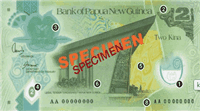 Obverse side of the 2 Papua New Guinean kina is showing the Bird of Paradise - National Emblem symbolising National Unity, the National Parliament Building. On this banknote also is showing the National Crest comprised of: a Tapa cloth from Central Province, a Mount Hagen axe, a Club from the Huon Gulf area, a clay pot from the Sepik, a shield from the Madang Area, a marriage bed from Manus Island and a shield from the Upper Sepik Region. |
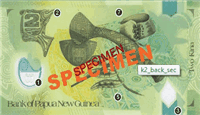 Reverse side of the 2 Papua New Guinean kina is showing the Mount Hagen axe, Kula armband from the Milne Bay Province, engraved dog's teeth from the Bougainville area and the clay pot from the Sepik Province. |
| 5 Papua New Guinean kina | |
|---|---|
| Banknote of 5 Papua New Guinean kina has dimensions 140×70 mm and main colors are rose quartz, silver, languid lavender, thistle, desert sand, caput mortuum and old lavender. The banknote of 5 Papua New Guinea Kina was issued in 2008. | |
 Obverse side of the 5 Papua New Guinean kina is showing the Bird of Paradise - National Emblem symbolising National Unity, the National Parliament Building. On this banknote also is showing the National Crest comprised of: the Parliament House design, the Shield from the Gulf Province, the Sepik clay pot and Ramu River shields from Madang area. The patterns surrounding the numerals are based on designs of a slaughtered pig. |
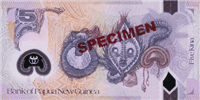 Reverse side of the 5 Papua New Guinean kina is showing the Hombuli mask which is used for bridal payments in the Sepik are, the Kina shell necklace woven with seeds found in the New Ireland Province. On this banknote also is showing an image comprised of: Parliament House design, Northern Province Tapa cloth, Milne Bay shield tortoise shell bracelets from the Huon Gulf area. The patterns used to surround the numerals are based on a mask design together with an illustration of a bird. |
| 10 Papua New Guinean kina | |
|---|---|
| Banknote of 10 Papua New Guinean kina has dimensions 150×75 mm and main colors are charcoal, purple taupe, taupe gray, pastel blue, fawn, pale spring bud and gainsboro. The banknote of 10 Papua New Guinea Kina was issued in 2008. | |
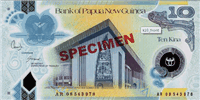 Obverse side of the 10 Papua New Guinean kina is showing the National Crest, National Parliament and a spear, symbolising National Unity. The National Crest is a stylised Bird of Paradise sitting on a Kundu (drum). |
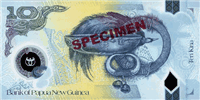 Reverse side of the 10 Papua New Guinean kina is showing the Tami Bowl, Feathers of the Bird of Paradise, Tambu Shell Money from the New Britain Area, Boars Tusks from the Highlands. Background tints for this value include patterns taken from: the Parliament House design, a Gulf Shield Ceremonial Dance Paddle from Bougainville, a Sepik Clay Pot, a Gulf Belt and Marriage Bed Posts from the Manus Province. |
| 20 Papua New Guinean kina | |
|---|---|
| Banknote of 20 Papua New Guinean kina has dimensions 150×75 mm and main colors are cordovan, light taupe, pale copper, tumbleweed, banana mania, peach-yellow, apricot, macaroni and cheese and beige. The banknote of 20 Papua New Guinea Kina was issued in 2007. | |
 Obverse side of the 20 Papua New Guinean kina is showing National Parliament Building, the National Crest which is a stylised Bird of Paradise sitting on a Kundu (drum) and a spear, symbolising National Unity. On this banknote also is showing an image comprised of: armband decorations from the Manus Island, decoration from a Kap Kap ornament from Manus Island, decoration from Pottery of the Sepik area, decoration from a "Spirit Board" of the Sepik area, a decoration from a mask of the Sepik area, shield decoration from a canoe Prow from the Milne Bay area. The local art form patterns surrounding the value numerals represent an impressionist lineal pattern of a pig. |
 Reverse side of the 20 Papua New Guinean kina is showing the Head of a boar, Toea arm band from Central Province, a Cowrie shell necklace from Madang area and shell ornament peculiar to the Western Province. The background tints incorporate linear patterns based on actual designs of various items as follows: designs taken from a Mount Hagen axe and shield from the Highlands, designs taken from Tapa cloth from the Northern Province, designs from a Kap Kap of the Manus area, decorations from a Shield from the Gulf area, decorations from a "Food Hok" from the Milne Bay area. |
| 50 Papua New Guinean kina | |
|---|---|
| Banknote of 50 Papua New Guinean kina has dimensions 150×76 mm and main colors are khaki, sunset, persian orange, grullo, antique brass, dark tan, pale gold and snow. The banknote of 50 Papua New Guinea Kina was issued in 2002. | |
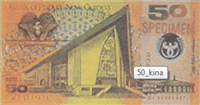 Obverse side of the 50 Papua New Guinean kina is showing a design of the National Parliament together with a reduced National Crest on the top left corner. The serial numbers and signatures of the Governor of the Bank of Papua New Guinea and the secretary for Finance appear on the side. |
 Reverse side of the 50 Papua New Guinean kina is showing portrait of Sir Michael Somare surrounded by designs of Headdress and masks. |
| 100 Papua New Guinean kina | |
|---|---|
| Banknote of 100 Papua New Guinean kina has dimensions 150×75 mm and main colors are dark sea green, medium spring bud, ash grey, sand, manatee and wenge. The banknote of 100 Papua New Guinea Kina was issued in 2005. | |
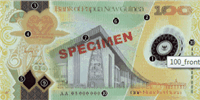 Obverse side of the 100 Papua New Guinean kina is showing the National Parliament Building and the Bird of Paradise - National Emblem symbolising National Unity. |
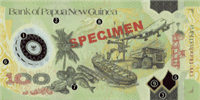 Reverse side of the 100 Papua New Guinean kina is showing the transition from the traditional primary economy towards the modern economy encompassing mining, petroleum, tourism, transportation and technology, coffee beans, coconuts, fish, palm tree, bamboo, ship, airplane, truck and radio tower. |
Useful links
- About Bank of Papua New Guinea:
- Bank of Papua New Guinea
- List of currencies:
- Currencies
- Security and design features of PGK banknotes:
- PGK banknotes
- PGK currency on Wikipedia:
- Papua New Guinean kina
- Official Website of Bank of Papua New Guinea:
- www.bankpng.gov.pg
- Commemorative coins:
- Commemorative Coins